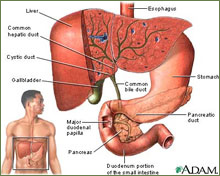Bile duct strictures

- What is a bile duct stricture?
- What are the causes of bile duct strictures?
- What will I experience if I have a bile duct stricture?
- How is a bile duct stricture diagnosed?
- How are bile duct strictures treated?
1. What is a bile duct stricture?
- A bile duct stricture is caused by narrowing of the bile duct
- The narrow bile duct prevents the bile from draining into the intestine
- The bile then backs up in the liver and spills over into the blood
2. What are the causes of bile duct strictures?
- There are many causes for biliary stricture
- These causes can be benign (non-cancerous) or cancerous
- Cancerous bile duct strictures are caused by bile duct cancer and pancreatic cancer
- Benign (non-cancerous) bile duct strictures may develop from chronic pancreatitis or injury to the bile duct after a laparoscopic cholecystectomy
- The most common cause for a benign bile duct stricture is trauma to the bile duct as a complication of a laparoscopic cholecystectomy for gallstone disease
- It is estimated that approximately 0.1% to 1% of gallbladder operations may lead to injury to the bile duct with subsequent development of a bile duct stricture
- In addition to injury to the bile duct, injury to the hepatic artery (the blood vessel that supplies blood to the liver) is commonly associated with a bile duct injury
3. What will I experience if I have a bile duct injury or stricture?
- Patients with bile duct injury after a laparoscopic cholecystectomy can present with the injury soon after the cholecystectomy or many weeks to months after the injury
- Patients who present early usually present with leakage of bile into the abdominal cavity
- Some of the symptoms that are associated with this include persistent pain and discomfort and feeling of illness after the laparoscopic cholecystectomy
- Patients recover rapidly after laparoscopic cholecystectomy and the majority of patients are back to their pre-surgery state within ten days to two weeks
- Patients who continue to complain of symptoms and are not improving should be evaluated for possible bile duct injury from laparoscopic cholecystectomy
- Often patients will develop fevers and jaundice
- Patients who develop delayed symptoms from a bile duct stricture usually have scarring of the bile duct from the injury
- These patients typically present with dilatation of their bile duct above the point of injury
- At the point of injury the scarring gives rise to narrowing so that bile cannot go through. The bile then spills over into their blood and they typically present with jaundice
4. How is a bile duct injury or stricture diagnosed?
- Diagnosis usually involves an ERCP (link) and follows blood and urine tests
5. Treatment of bile duct injuries
- Early detection of bile duct injuries is important and with appropriate treatment patients generally do well. The principles of treatment of bile duct injury include:
- Treatment of all infection and sepsis that may develop from leakage of bile or due to blockage of bile
- Repair of the damaged bile duct through surgery
- In the repair of the damaged bile duct, a segment of intestine is brought up to the bile duct and the bile duct is then sutured to the intestine. For long term healing and for good results a normal uninjured bile duct away from the site of the injury should be used. This may be difficult to accomplish in high bile duct injuries
|